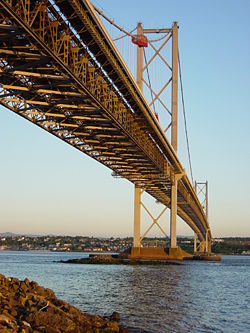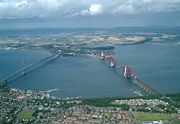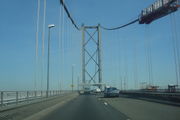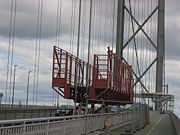Forth Road Bridge
2008/9 Schools Wikipedia Selection. Related subjects: Engineering; Road transport
| Forth Road Bridge | |
|---|---|
 The Forth Road Bridge, viewed from the Fife side, straddling the Firth of Forth. |
|
| Official name | Forth Road Bridge |
| Carries | Motor vehicles ( A90 road) Cyclists ( National Cycle Route 1) Pedestrians |
| Crosses | Firth of Forth |
| Locale | Edinburgh, Scotland |
| Maintained by | Forth Estuary Transport Authority |
| Design | Suspension bridge |
| Longest span | 1,006 m (3,298 ft) |
| Total length | 2,512 m (8,242 ft) |
| Width | 33 m (110 ft) Dual two-lane carriageway, two cycle/footpaths |
| Clearance below | 44.3 m (145.3 ft) |
| AADT | ~32,000 vehicles (2004 estimate) |
| Opening date | 4 September 1964 |
| Toll | Free since 11 February 2008 |
| Coordinates | Coordinates: |
The Forth Road Bridge is a suspension bridge in east central Scotland. The bridge, built in 1964, spans the Firth of Forth, connecting the capital city Edinburgh at South Queensferry to Fife at North Queensferry. The bridge replaced a centuries-old ferry service to carry vehicular traffic, cyclists, and pedestrians across the Forth; rail crossings are made by the adjacent and historic Forth Bridge.
Issues regarding the continued tolling of the bridge, and those over its deteriorating condition and proposals to have it replaced or supplemented by an additional crossing, have caused it to become something of a political football for the Scottish Parliament which eventually voted to scrap tolls on the bridge with effect from 11 February 2008.
History
The first crossing at what is now the site of the bridge was established in the 11th century by Margaret, queen consort of King Malcolm III, who founded a ferry service to transport religious pilgrims from Edinburgh to Dunfermline Abbey and St Andrews. Its creation gave rise to the port towns which remain to this day, and the service remained in uninterrupted use as a passenger ferry for over eight hundred years. As early as the 1740s there were proposals for a road crossing at the site, although their viability was only considered following the construction of the first Forth bridge in 1890.
The importance of the crossing to vehicular traffic was underpinned when the Great Britain road numbering scheme was drawn up in the 1920s. The planners wished the arterial A9 road to be routed across the Forth here, although the unwillingness to have a ferry crossing as part of this route led to the A90 number being assigned instead.
There was a period of renewed lobbying for a road crossing in the 1920s and 1930s, at which time the only vehicle crossing was a single passenger and vehicle ferry. Sir William Denny championed the expansion of that service in the 1930s, providing and operating two additional ferries on behalf of the London and North Eastern Railway that aimed to supplement the services of the adjacent railway bridge. Their success allowed for the addition of two more craft in the 1940s and 1950s, by which time the ferries were making 40,000 crossings, carrying 1.5 million passengers and 800,000 vehicles annually.
With the then-newest and nearest bridge spanning the Forth (the Kincardine Bridge, built in 1936) still around 15 miles (24 km) upstream, the upsurge in demand for a road crossing between Edinburgh and Fife prompted the UK government establish the Forth Road Bridge Joint Board by Act of Parliament in 1947 to oversee the implementation of a new bridge to replace the ferry service. The final construction plan was accepted in February 1958 and work began in September of that year.
Mott, Hay and Anderson and Freeman Fox & Partners carried out the design work and Sir William Arrol & Co. constructed the bridge at a cost of £11.5 million, while the total cost of the project including road connections and realignments was £19.5 million. Seven lives were lost during construction before the bridge was opened by Queen Elizabeth II and the Duke of Edinburgh on 4 September 1964. The ferry service was discontinued as of that date. The bridge's management was delegated to the FRBJB, and remained so until 2002 when its operation was transferred to a new body with a wider remit, the Forth Estuary Transport Authority.
Statistics
The bridge's central main span is 1,006 m (3,298 ft) long, its two side spans are each 408 m (1338 ft) long, and the approach viaducts are 252 m (827 ft) on the north side and 438 m (1,437 ft) on the south side; at a total length of 2,512 m (8,242 ft), it was the longest suspension bridge outside the United States and the fourth-largest in the world at the time of its construction. The bridge comprises 39,000 tons of steel and 115,000 cubic metres of concrete. Its width comprises a dual carriageway road with two lanes in each direction bounded by cycle/footpaths on each side. The main strung cables are 590 mm in diameter and each carries 13,800 tonnes of the bridge's load by suspending 11,618 5 mm diameter high tensile wires.
The bridge forms a crucial part of the corridor between south-east and north-east Scotland, linking Edinburgh to Perth, Dundee and Aberdeen by the A90 road and its sister M90 motorway which begins a few miles north of the bridge's northern terminus. The bridge carried around 2.5 million vehicles in its first year but the annual figure has risen steadily over time to around 11.8 million vehicles in 2004 alone. The bridge carried its 250 millionth vehicle in 2002.
It was awarded Historic Scotland's Category A listed structure status in 2001.
Tolling issues
On 11 February 2008 tolls were abolished on the bridge.
Initially, it was suggested that tolling would cease once the original cost of construction plus interest accrued had been repaid - this was done in 1993 and tolls were planned for removal by May 1995. However, the legislation enabling the levying of tolls has instead been renewed by Parliament (originally that of the UK but now the responsibility of the Scottish Parliament) on three separate occasions in 1998, 2003 and 2006.
Originally, a toll was paid for each direction of travel with sets of toll booths on both carriageways. In 1997, a decision was made to double the northbound toll (then 40p, to 80p) and remove the southbound toll. The belief was that almost all traffic makes a return journey across the bridge, resulting in a reduction of congestion for southbound traffic without reducing overall toll revenues.
The Forth Estuary Transport Authority (FETA) has justified the continued use of tolls by suggesting they are necessary to fund maintenance and improvement works. These include the construction of defences around the submerged piers forming the bases of the main towers in the event of collision in the Firth. The main towers have also been strengthened with internal steel columns (the original tower structure having been hollow) and had hydraulic rams jack up these sections to transfer a portion of the load to the new steelwork. Also, the vertical cables suspending the deck have had their bolts replaced after a single detected failure. A new paint system required development for the bridge (the original having been phased out due to environmental concerns) and the toll plaza and booths have been replaced allowing more comfort for toll-collection staff and the introduction of electronic tolling.
Variable tolling proposals
| Start | End | Toll |
| 00:00 | 07:30 | £1 |
| 07:30 | 08:30 | £2 |
| 08:30 | 14:00 | £1 |
| 14:00 | 15:00 | £2 |
| 15:00 | 16:00 | £3 |
| 16:00 | 18:00 | £4 |
| 18:00 | 18:30 | £3 |
| 18:30 | 19:00 | £2 |
| 19:00 | 24:00 | £1 |
| source: Edinburgh Today | ||
In late 2005, FETA's committee approved a proposal for a complete revamp of the system of toll levies. The minimum toll would be set to the existing £1 figure, but would increase dependent on the time of day, rising to a maximum of £4 for evening rush hour travel. All tolls would be halved for cars with more than one occupant, as an incentive to drivers to share cars and make fewer journeys. According to FETA's chairman Lawrence Marshall, the system would provide the most efficiency, claiming that 80% of peak-time journeys are made by single-occupant vehicles. The proposal, passed with the chairman's casting vote after the committee was deadlocked, was referred to the Scottish Executive in December 2005, and implementation planned for October 2007 subject to approval by transport minister Tavish Scott. Environmental groups welcomed the proposal, although local politicians condemned it as simply a means of raising capital. At the same time, a counter-argument was tabled by Fife councillors proposing the complete removal of tolls.
The Scottish Parliament debated the proposals in January 2006, and the affair became a major political issue after Westminster-based MPs Gordon Brown and Alistair Darling ( Chancellor of the Exchequer and Secretary of State for Scotland respectively) were seen to describe the variable tolling plan as "dead in the water". Scottish First Minister Jack McConnell insisted his Labour Party colleagues were misquoted and himself refused to rule out the plan, receiving considerable condemnation from the opposition Scottish National Party.
The political situation was particularly important given that by late January 2006, campaigning was well underway for a by-election scheduled to take place for the Westminster constituency of Dunfermline and West Fife in which the north end of the bridge is situated. The by-election, scheduled for February 9, was contested by - in addition to the major political parties in Scotland - an Abolish Forth Bridge Tolls Party. It was eventually won by Liberal Democrat candidate Willie Rennie, overturning a large Labour majority on a 16% swing.
In the aftermath of the by-election defeat, media speculation suggested the Executive had turned against the proposals, and Tavish Scott eventually confirmed their rejection and the retention of the existing toll structure on 1 March 2006. FETA condemned the decision, while local opposition MSPs charged the minister that his tolling review short-changed Fifers as tolls were axed on the Erskine Bridge leaving tolls on only the Forth and Tay Road Bridge, both in Fife.
Abolition
Following the formation of an SNP minority government after the Scottish parliamentary election of May 2007, a new debate on the abolition of tolls was opened by Transport Minister Stewart Stevenson on May 31, 2007, where it was approved in principal by a unanimous vote. Toll levies at that point totalled £16 million annually.
The Abolition of Bridge Tolls (Scotland) Bill, required to revoke legislation mandating toll collection on the bridge, was introduced to the Scottish Parliament on 3 September 2007, passed on 20 December 2007, and received royal assent on 24 January 2008. The tolls were removed on 11 February 2008 at 00:01 GMT.
Structural issues
There has been concern at FETA over the structural wear-and-tear of the bridge. The planned theoretical capacity for the bridge (30,000 vehicles per day in each direction) is routinely exceeded as traffic levels have outstripped predictions. FETA predicts the demand could rise to an average of 40,000 vehicles per day in each direction by 2010 and the Scottish Executive admit that 60,000 vehicles is not uncommon for weekday travel. This has raised concerns about the lifespan of the bridge, originally planned at 120 years.
2003 saw an inspection programme launched (at a cost of £1.2 million) to assess the condition of the bridge's main suspension cables after excessive corrosion was discovered in a number of older bridges in the United States of a similar design and size. The study, which was completed in 2005, found that the main cables had suffered an estimated 8-10% loss of strength. Future projections highlight the likelihood of an accelerating loss of strength, with traffic restrictions to limit loading required in 2014 in the worst case scenario, followed by full closure as early as 2020. There have been allegations of poor workmanship on the bridge which, combined with the adverse weather while it was being constructed, has led to speculation that these steel wires have become crossed instead of being parallel as intended.
Further monitoring and remedial work is now under way. An "acoustic monitoring" system was commissioned in August 2006, which uses listening devices to monitor any further strands snapping and pinpoint their location within the main cables.
Given the significance of the findings of the first internal inspection, in November 2005 the Scottish Executive appointed Flint & Neill Partnership to audit the results. The purpose of the audit was to carry out a desk study of the findings and to advise the Scottish Executive whether those findings were reached using a process of appropriate rigour and whether the conclusions were reasonable. Flint & Neill appointed New York based Ammann & Whitney to act as sub-consultants providing specialist advice using experience gained from inspections and assessments carried out in America. In January 2006, an audit report to the Scottish Executive concluded that FETA’s consultant performed the initial internal inspection and cable strength calculation in accordance with accepted practice in the United States and in general conformance with accepted industry guidelines published in 2004 by the NCHRP. Flint & Neill noted that the initial investigation by FETA “was not prompted by the discovery of any concerns with the Forth Road Bridge cables but as a prudent response to the results of findings in the USA. When the original scope for this initial investigation was determined, the severity of the findings was not anticipated.” The audit report suggested that traffic restrictions could be required as early as 2013.
A number of options are being implemented to increase the bridge's lifespan. These include an extensive dehumidification programme to slow the rate of corrosion in the main cables by installing a system that will keep the air in the voids between the strands that make up the main cables at a humidity level of below 40%. Engineering consultants Faber Maunsell began work on the project in 2006. The works are planned to take two and a half years at a cost of £7.8 million. As part of the works, some of the corroded cable strands are to be spliced.
Proposals for a new Forth Road Bridge

With a complete closure of the existing Forth Road Bridge predicted by approximately 2020 without drastic action, there is a threat of serious economic consequences, due to the strategic importance of the bridge in the Scottish transport network and the estimated 10-year-plus timescale for construction of a replacement.
Proposals for an additional road crossing had initially been drawn up in the early 1990s, but met stiff opposition from environmentalists and from Edinburgh City Council on the grounds of the increased traffic it would generate. Following the Labour victory in the 1997 General Election, the proposals were shelved; however, they have resurfaced as of 2005, given the concerns over the existing bridge's lifespan. A new cable-stayed bridge has been announced at an estimated cost of between £3.25 billion and £4.22 billion. There remains considerable opposition to the project on the same grounds as before, particularly from the Scottish Green Party.
The funding for the new bridge is uncertain: the Scottish Government intends to replace Public-private partnership funding for such schemes with the Scottish Futures Trust, but details for this have not been agreed. Construction industry trade newspaper Construction News reports that work on the new bridge is planned to run between 2011 and 2017.


